
A partial skeleton from an Oligocene dolphin species was found in South Carolina, according to a study published November 8, 2017 in the open-access journal PLOS ONE by Robert Boessenecker from the College of Charleston, South Carolina, USA, and Erum Ahmed and Jonathan Geisler from the New York Institute of Technology, New York.
Previous research has shed light on the early evolutionary history of toothed whales, and particularly xenorophid dolphins – the earliest group of echolocating dolphins. Since the archaeological record for Xenorophidae is very limited, prior studies have focused on the crania or earbones of xenorophid dolphins.
The authors of the present study report five new specimens of xenorophid dolphins from North and South Carolina. Four of the specimens belonged to the xenorophid Albertocetus meffordorum, and one contained a partial skeleton including ribs, vertebrae, and chevrons as well as a partial skull and mandible. Since these specimens were collected from formations dating to the Oligocene (33.9 million to 23 million years before the present), this finding extends the known evolutionary history for this group.
The researchers studied the internal anatomy of the Albertocetus cranium using CT scan data, revealing that its brain was quite large in size, the largest yet for an early Oligocene toothed whale. Brain anatomy was further intermediate between modern cetaceans (such as dolphins, whales, and porpoises) and terrestrial even-toed hoofed animals (such as pigs, deer, and sheep). The partial vertebral column indicates that Albertocetus retained a similar shape and moved similarly to its archaeocete ancestors that lived 40 to 35 million years ago. Vertebrae from the tail indicate that Albertocetus had tail flukes like modern dolphins, but not a caudal peduncle – a narrow tail stock seen in all modern whales and dolphins.
The authors suggest that further collecting efforts in North and South Carolina might yield additional cetaceans that are contemporary with the specimens described in this study, and would continue to piece together the evolutionary history of this species.
The lead author Robert Boessenecker says, “Fossils like these new specimens of Albertocetus are critical windows into the earliest evolution of modern whales, and shed light on the split between baleen whales and echolocating whales about 30-35 million years ago.”
Reference:
Boessenecker RW, Ahmed E, Geisler JH (2017) New records of the dolphin Albertocetus meffordorum (Odontoceti: Xenorophidae) from the lower Oligocene of South Carolina: Encephalization, sensory anatomy, postcranial morphology, and ontogeny of early odontocetes. PLoS ONE 12(11): e0186476. DOI: 10.1371/journal.pone.0186476
Note: The above post is reprinted from materials provided by Public Library of Science.










